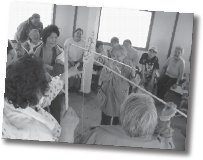When you teach a skill to others, you must learn it very well yourself first. You need to think about the steps involved and techniques for being successful at the skill. Passing on a skill gives you a sense of personal and cultural pride.
Ideas for Skills Demonstrations
- Learn how to perform a skill – through research, listening to existing oral
history recordings, speaking with Elders and through practice. Here are some
examples of skills: making a tool, iglu, qajaq, qamutik, preparing skins and
sewing an article of clothing, playing a game, drumming, square dancing or
throat singing.
- You could teach that skill to other members of your group.
- Teach the skill to children – bring your own children to your literacy group;
demonstrate the skill and give the children a chance to try it. Teach a class at
school or an after-school session at the library or Community Learning Centre.
- Hold several evening sessions at the Community Learning Centre where other
adults can come and learn from you.
- Plan and coordinate events where Elders can demonstrate skills.
- Volunteer to demonstrate skills at a museum or cultural centre – or as part
of an orientation for new teachers, government workers or tourists from the
south.
Planning the Event

- First decide if you will need a budget – to pay Elders and buy materials – and
if so, where will you get the funding? Plan in advance.
- Once your project is up and running, begin to prepare for your teaching
events. First, brainstorm as a group how you are going to introduce and
explain the skill. Who is going to do what? Who is going to arrange the space
for the event, ask for donations of materials or food, invite guests and Elders,
advertise your event? Make a work plan and post it on the wall so everyone
can keep track of their jobs.
- If you are going to be speaking at an event, write down what you plan to say
on cards. Hold practice sessions in front of your whole group so people can
get feedback and feel comfortable with their role.
- Try to use some traditional vocabulary that you’ve heard from the Elders as
they taught you the skill. Think about how you can use these words, explain
them and help others learn them. You might make posters showing the
meaning of words or handouts that people can take home.
- You could make posters of the steps in performing the skill – with drawings
and text. (To make large drawings, project original drawings onto large sheets
of paper on the wall with an overhead projector and trace around them.) Put
these posters in the room where you are demonstrating the skill.
- You could create PowerPoint presentations on the computer.
- The facilitator teaches mini-lessons on the writing process, syllabic
keyboarding, grammar and any other topics as they come up.
- The literacy group members could write journal entries throughout the project.
What are your thoughts and feelings about learning the skill and about
teaching it to others?

